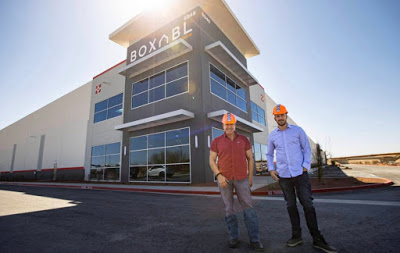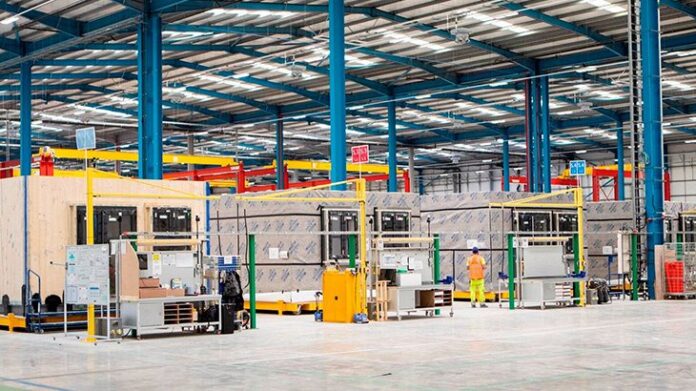Advice from people who have recently managed the process
by Zena Ryder
• Clearly define the steps required to build your product
• Look to offer technological advancements
• Create bulletproof processes for everything
• Automate incrementally and only as needed
• Be absolutely clear on your market, customers, products and services
Before you embark upon the daunting task of opening a modular factory, you may want to learn from those who have already walked the path.
With this in mind, we asked five manufacturers – all of whom have recently opened new factories – about the challenges they faced, how they overcame those challenges, what surprised them about the process, and what their advice would be to other companies contemplating new facilities.
We spoke with representatives at BMarko Structures, Boxabl, Impresa Modular, Method Homes and Plant Prefab. Their factories are located across the country with sizes that vary from 20,000 to 240,000 square feet. The companies themselves range from start-ups to firms that have been around since the Great Recession of 2008.
BMarko Structures
Greenville, South Carolina — 86,000 square feet
Antony Kountouris, CEO

BMarko has been producing student/senior housing and commercial, industrial and hospitality buildings at a 50,000 square foot facility in Dacula, Georgia. This new plant, which opened in December 2020, will produce multi-family residential buildings.
What were the big challenges? How did you overcome them?
We had a tight, pre-committed schedule on a large project before we decided to build the factory, hire people or acquire equipment (other than prefabricated jigs.)
That project commitment required us to start production while we were still setting up the factory. We also had to establish new vendor relationships because our first factory builds commercial, rather than multi-family, products. Supply chain issues were a challenge as well, with some vendors not honoring the prices or delivery schedules we had agreed upon.
Because of these challenges, we ended up working seven days a week from 8 am to 10 pm.
What surprised you most?
We were shocked by the “COVID Couch” phenomenon. Some people preferred to collect COVID relief checks instead of returning to work. Even now, fewer workers are returning than before the pandemic. It resembles the 2008 era, but on a smaller scale. We had to be more creative with our recruiting channels, and hire and train less-experienced workers.
How would you advise those wanting to open a new factory?
Understand your product exactly, including all the minute steps required to build it. And define as much detail about the plant layout as possible before you start building the plant.
Challenges with the plant can feel never-ending: spacing of crane columns, design of lifting bars, concrete thickness needed for crane columns, plant flow, logistics of receiving/delivering material to the production line, hiring and training workers, establishing inventory areas, creating a material part numbers list, etc.
If you had a crystal ball that revealed all these challenges, you likely wouldn’t want to do it. Some naiveté comes in handy.
Boxabl
Las Vegas, Nevada — 170,000 square feet
Galiano Tiramani, Founder

Boxabl builds foldable tiny homes. This is the company’s first plant, which opened in 2021.
What were the big challenges? How did you overcome them?
We’re building an entirely new type of housing so there aren’t any established factories to replicate. We created a plan, but things changed when we got to reality. In moving from 3D models to real life, we learned lots of ways to improve the product and the manufacturing process.
We also ran into COVID supply chain issues. We had delays and price increases on almost every item.
What surprised you most?
I was surprised by how smoothly things went. It wasn’t easy, but there were no major problems or showstoppers. We had an experimental product and we set out to open a 170,000 square foot manufacturing facility with no experience. We managed to pull it off in the midst of a pandemic and we’ve started building and delivering houses.
How would you advise those wanting to open a new factory?
My advice? Don’t do it unless your factory will include significant technological advancements when compared to traditional manufacturing.
The traditional modular formula has been around for 50+ years and has largely failed to gain market share. It’s a failed business model. If it worked, all houses would be built like that.
The way to succeed in modular is with technological breakthroughs. Traditional modular houses are too big to ship very far cost-effectively. We solved the shipping problem.
Impresa Modular
Greenwood, South Carolina — 240,000 square feet
Dan Hobbs, President, Impresa Building Systems of Greenwood

Impresa is a franchise business that sources modular homes from more than twenty factories. This is the company’s first in-house factory. It will build pre-designed, configurable homes.
What were the big challenges? How did you overcome them?
East Coast modular factories are mostly clustered in the Northeast. There is little talent available outside that cluster, so our location in South Carolina made hiring a challenge.
However, we’ve been blessed to attract several highly-experienced senior professionals. We’ve also hired a number of talented people who will report to them. I also can’t say enough about the help we received from the state through their ready SC and SC Works programs.
What surprised you most?
Really, there were no surprises. I have run six operations before — mostly turnarounds of poorly performing plants — so I came in with my eyes wide open.
How would you advise those wanting to open a new factory?
Process, process, process. A new factory is an opportunity to do everything right from the beginning — fastidious safety and housekeeping, rigorous quality processes and procedures, positive plant culture, design discipline, high expectations, etc.
Method Homes
Ferndale, Washington — 70,000 square feet
Brian Abramson, Founder & CEO

Method builds custom and pre-designed single-family homes, as well as multi-family, commercial, educational, and hospitality buildings.
This plant, the company’s second, opened in 2021. It’s next to their first, which is 25,000 square feet.
What were the big challenges? How did you overcome them?
We were building during the pandemic so we had supply chain issues like everyone else did. Some of our automation equipment was stuck at the port for a month.
And although we started building the factory in May, we didn’t get our big roll-up garage doors until July. So much for building in a secure, climate-controlled environment. We engaged after-hours security until the doors arrived.
What surprised you most?
We were lucky with the weather. We broke ground in September 2020 and started building projects in May 2021. If we’d been building the factory this past fall and winter instead, the whole process would have been much slower because the weather was so bad.
Also, we ordered the steel package for the factory building just before the price of steel rose by 30%. We may not have been able to move forward if we had waited.
How would you advise those wanting to open a new factory?
Build bigger than you think. When we started the planning process we didn’t anticipate how much busier we would become. We could have used a facility twice as big.
Also, add automation incrementally. Apart from the cost involved, there’s a huge learning curve with automation. I’ve seen lots of factories with under-used automation equipment.
Plant Prefab
Ontario, California — 20,000 square feet
Steve Glenn, CEO

Plant Prefab builds custom single-family and multi-family homes as well as student housing and hospitality buildings. This factory opened in 2021 and is their second. Their first is a 62,000 square foot facility in Rialto, California.
The company will be opening a third one later this year, a 270,000 square foot facility near Bakersfield, California.
What were the big challenges? How did you overcome them?
It was difficult to find labor. Our response has been to offer exceptional value to our employees, such as a predictable schedule and a strong compensation and benefits package that includes equity in the company.
We also had to train the team on the new building system we introduced last year, which was a big learning curve.
What surprised you most?
Because we’re always hearing about the decline of manufacturing in the US, I was surprised it was so hard to find a space for our factory. But a lot of former manufacturing facilities have been taken over by distributors.
How would you advise those wanting to open a new factory?
Do your homework. Make sure you’re clear on your market, your customers, your products and services, as well as the space, labor, and equipment you need to execute your plan. Many new factories have shuttered over the last few years because they didn’t get these right.
Zena Ryder is a freelance writer who writes about construction for businesses, magazines, and websites. Find her at zenafreelancewriter.com.

















